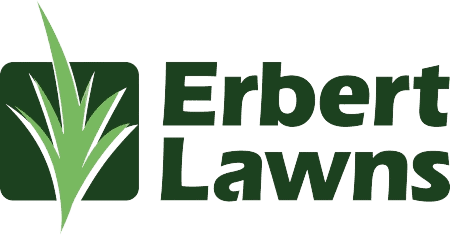
Choosing the right method to grow a healthy, long-lasting lawn is more than a cosmetic decision; it’s a strategic one. The two most common options, sod and seed, each come with unique advantages and challenges. Erbert Lawns helps homeowners weigh these factors, from upfront costs to ongoing maintenance. We understand the importance of selecting the right method to suit your needs, budget, and timeline.
Key Takeaways
- Sod delivers instant results but requires a greater initial investment.
- Seeding is more budget-friendly but requires patience and diligent care.
- Maintenance needs differ: sod demands intensive initial watering; seed requires longer-term attention.
- Grass variety options are broader with seeding.
- Your choice should align with your specific lawn goals and conditions.
Establishing a new lawn can be an exciting yet challenging task for homeowners, landscapers, and property managers. Whether you’re looking to replace an old, patchy lawn or establish a completely new one, one of the first decisions you’ll need to make is whether to go with sod or seed. Both sod and seed have their advantages and drawbacks, particularly in terms of costs, maintenance, and time commitment. Understanding the differences between the two options can help you make a more informed decision based on your needs, budget, and long-term plans for your lawn.
Here are the comparison between sod and seed lawn establishment in terms of their costs, maintenance requirements, and overall suitability for different types of projects.
1. Cost Comparison
When it comes to the cost of establishing a new lawn, there is a clear distinction between sod and seed. Sod is typically more expensive than seed for a variety of reasons, but the investment may be worthwhile depending on your circumstances.
-
Sod Costs:
Sod pricing depends on factors like location, grass variety, and supplier. On average, sod costs between $0.30 and $0.80 per square foot, often including delivery and occasionally installation. When opting for professional installation, the total expense may rise to between $1.50 and $2.50 per square foot, influenced by local labor rates.
-
Seed Costs:
Grass seed is much less expensive than sod. The average cost of grass seed is around $0.10 to $0.25 per square foot. However, the price can vary depending on the type of seed (e.g., Kentucky bluegrass, fescue, or Bermuda grass) and the quality of the seed. While the initial cost for seed is significantly lower than sod, you’ll need to factor in additional costs for soil preparation, watering, and fertilization, which may bring the total cost closer to sod in some cases.
Overall Cost Comparison:
Sod is a more expensive option upfront, but it offers immediate results. If you’re looking for an instant lawn, sod is the way to go. However, seed is the more economical choice if you’re willing to invest time and patience into the establishment of your lawn. For large areas, the difference in cost can be significant, with sod costing several times more than seed. Ultimately, the decision will depend on your budget and how quickly you want your lawn to look fully established.
2. Time to Establishment
One of the most notable differences between sod and seed is the time required for the lawn to become fully established.
-
Sod Establishment:
When you install sod, the grass is already mature and ready to root into the soil. Typically, it takes about 2 to 3 weeks for the sod to establish its roots in the ground. Within this short period, you can enjoy a lush, green lawn. However, even though the grass is in place, sod requires ongoing care for the first few weeks to ensure successful rooting and growth. Regular lawn watering, proper mowing, and occasional fertilization are essential to promote healthy growth.
-
Seed Establishment:
In contrast, grass seed requires a significantly longer period to grow and fully establish. Depending on the type of grass and the environmental conditions, seed can take anywhere from 2 to 6 weeks to germinate, and the lawn can take several months to fill in. This slower growth means that you won’t see instant results. It may take one full growing season (often 3 to 6 months) before the lawn matures and becomes fully established. During this time, you’ll need to be patient and consistent with watering, fertilizing, and mowing to support the grass as it grows.
Time Comparison:
For a lawn that’s ready for use right away or within a few weeks, sod is the most practical option. Seed, while less expensive, requires a longer waiting period and more ongoing care to get to the same level of fullness and aesthetic appeal.
2. Maintenance Requirements
While both sod and seed lawns require regular maintenance, there are key differences in how much time and effort are involved, particularly in the early stages of establishment.
-
Sod Maintenance:
Sod requires less initial care in terms of soil preparation, as it is already mature grass. However, the establishment of sod still requires considerable attention for the first few weeks. Regular watering is crucial for the roots to take hold. Over-watering can cause the sod to rot, while under-watering can lead to dry patches. After the sod has rooted, regular mowing and lawn fertilizer are necessary to maintain a healthy and beautiful lawn.
One thing to keep in mind with sod is that it may require more maintenance in the long term to address potential issues like weeds or uneven growth. Because sod is typically grown in a controlled environment, there’s a possibility that some patches may not root evenly, requiring additional care and patching later on.
-
Seed Maintenance:
Planting grass seed involves more thorough soil preparation before sowing. This includes soil aeration, removing any existing grass or debris, and ensuring that the soil is loose and fertile enough for seed germination. After seeding, the soil must be kept consistently moist, which can be a challenge if there are periods of dry weather.
As the grass begins to grow, it will require mowing, fertilization, and ongoing care to ensure that the new grass becomes thick and lush. Weed control is another consideration with seeded lawns, as the grass is still vulnerable to competition from weeds during its early stages of growth. Additionally, if parts of the lawn fail to germinate, you may need to overseed certain areas, adding to the maintenance workload.
Maintenance Comparison:
While sod requires less preparation and is easier to establish, it also demands attention to ensure proper rooting. Seed lawns, on the other hand, require more time and effort during the establishment phase, but once the grass has matured, it can be just as easy to maintain as sod. In the long run, seed may be less demanding than sod, depending on how well the lawn is established.
4. Suitability for Different Landscapes
The choice between sod and seed also depends on the type of landscape and the specific needs of the lawn.
Sod is Ideal For:
- Those looking for immediate results or an instant green lawn.
- Areas with erosion concerns, where quick ground coverage is needed to prevent soil loss.
- Homeowners with limited time or resources to wait for grass to establish.
Seed is Ideal For:
- Budget-conscious individuals who are willing to invest time in long-term savings.
- Large properties where the cost of sod would be prohibitively high.
- Homeowners who are patient and want to gradually build a lush lawn over time.
Making the Right Choice
Your decision between sod and seed should consider:
- Budget: If cost is a primary concern, seeding is more economical.
- Timeframe: For immediate results, sod is the preferred choice.
- Lawn Size and Terrain: Sod is advantageous for sloped areas prone to erosion.
- Personal Commitment: Seeding requires patience and consistent lawn care service during establishment.
Conclusion
Choosing between sod and seed depends on your specific needs, budget, and the level of maintenance you’re prepared to undertake. At Erbert Lawns, we’re committed to helping you achieve the lawn of your dreams. Whether you opt for the instant beauty of sod or the cost-effective approach of seeding, our team of professionals is here to guide you every step of the way. Ready to transform your lawn? Contact Erbert Lawns today for expert advice and services tailored to your needs.
FAQs:
How long does it take for sod to establish?
Sod typically takes 2-3 weeks to root and become established, provided it’s watered adequately during this period.
When is the best time to seed a lawn?
The ideal times for seeding are early fall and spring when temperatures are moderate, and there’s adequate rainfall.
Can I walk on newly seeded lawns?
It’s best to avoid foot traffic on newly seeded areas until the grass has matured, usually after the first few mowings.
Does sod require less maintenance than seed?
Initially, sod requires intensive watering, but once established, it generally needs less maintenance than a newly seeded lawn.
Which option is better for shaded areas?
Seeding allows for selecting shade-tolerant grass varieties, making it more suitable for areas with limited sunlight.









